|
|
|
|
III.1 Surface Modification - Chemical
and Biochemical
|
| This
work is supported by: DURINT-01 AFOSR Grant No. F49620-01-1-0474
|
|
Contact
between proteins and surfaces is a common occurrence
in a wide variety of contexts, ranging from drug
delivery systems to sensors to prosthetics. A
less commonly realized and examined aspect is
the potential use of the self-assembling nature
of polypeptide monomers to achieve regular patterns
of protein two-dimensional crystals on solid surfaces
through cooperative adsorption from appropriate
solution. We are carrying out experimental and
modeling/simulation studies to gain a deeper understanding
of the nature of the phenomena involved in achieving
the objective of patterned protein film formation
on semiconductor and ceramic surfaces over reasonable
local area in microns.
|
| I. SAMs on
Semiconductor surfaces - Silicon and GaAs:
|
|
A. Silicon
Following are illustrations of some of our work
done on the self assembly of organic chains onto
Silicon surfaces to form self-assembled monolayers
(SAMs).
|
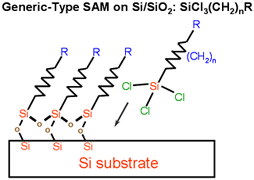
|
|
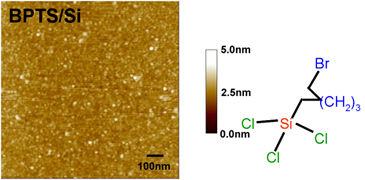
AFM image of 3-bromopropyl-tricholoro-silane 0028BPTS) SAM modified Si(001) surface
|
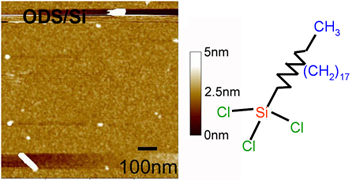
AFM image of octadecyl-tricholorosiloxane (ODS) SAM modified Si(001) surface
|
|
Application to Protein Absorption
We
are carrying out studies for adsorption of a mutant
chaperonin (TF55) protein on 3-bromopropyl-tricholrosilane
(BPTS) modified Si(001) as shown in the schematic
below (left picture). The chaperonin is provided
by NASA AMES Laboratory (Dr. J. Trent). Compared
to the bare Si surface, BPTS significantly improves
adsorption efficiency of the chaperonin by covalently
attaching to exposed cysteine group on chaperonin
through thiol-ether linkage. This is manifested
in the high coverage of chaperonin seen in the
AFM image of such a sample (right picture). This
research is supported by the National Nanotechnology
Initiative under the DURINT (Defense University
Research Initiative in Nanotechnology) program.
|
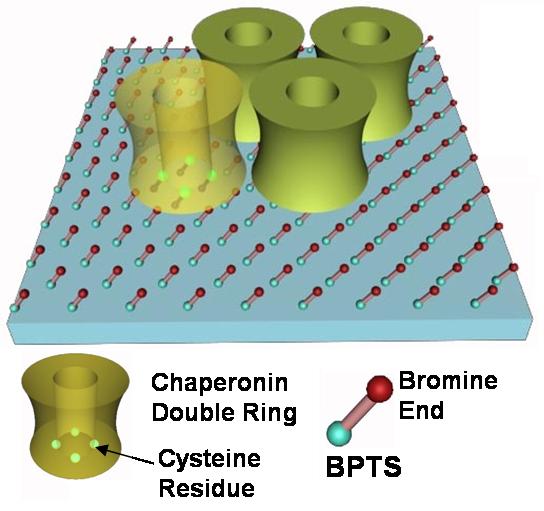
|
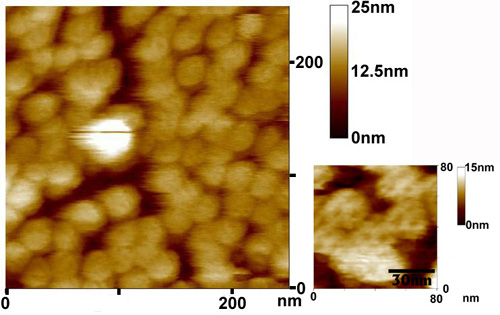
|
Schematic of silicon surface modification with 3-bromopropyl-trichlorosilane
self-assembled monolayer (SAM) for enhanced adsorption of proteins
via exposed cystein residues.
|
AFM image shows efficient adsorption of mutant Chaperonin on 3-bromo-propyl-trichlorosilane
modified Silicon surface. Inset: higher resolution AFM image shows
that disc-shaped ~30nm diameter feature could be few-mers formed
by aggregation of 3 or 4 chaperonin rings.
|
|
B. GaAs
Following are illustrations of some of our work
done on the self assembly of organic chains onto
GaAs surfaces to form self-assembled monolayers
(SAMs).
|
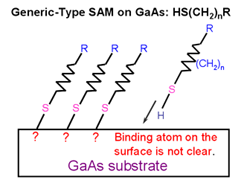
|
|
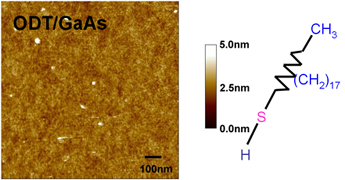
AFM image of 1-octadecanethiol (ODT) SAM modified GaAs (001) surface
|
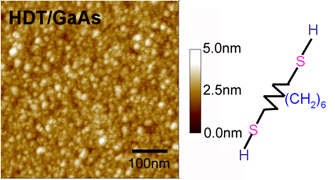
AFM image of 1, 6-Hexanedithiol (HDT) SAM modified GaAs (001) surface
|
|
Application to Nanocrystal adsorption
SAM molecules with thiol end can be used as bi-linkers
between nanocrystals such as CdSe, InAs, ZnSe,
etc and semiconductor surfaces. The SAM enables
the adsorption of nanoparticles on surface.
|
|
|
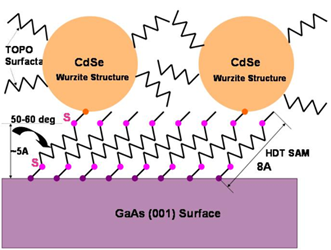
Schematic of CdSe nanoparticles adsorbed
onto GaAs substrate through HDT SAM
|
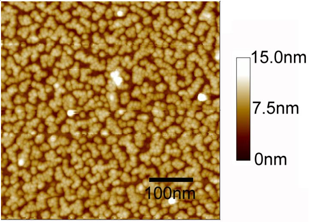
AFM image of CdSe nanoparticles adsored on HDT modified GaAs surface
|
|
II. Insulating substrates
- Glass and Alumina
A. Glass

Schematic of APTS SAM adsorption on Glass
|
|

Optical fluorescence images of plain (left),
and APTS reacted glass surface (right) treated
with Fluorescein Isothiocyanate (FITC).
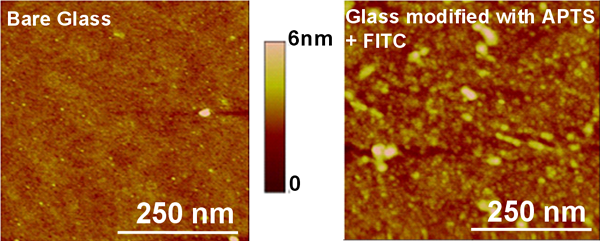
AFM images of plain (left), and APTS reacted
glass surface (right) treated with Fluorescein
Isothiocyanate (FITC).
The uniformity of
the surface coverage of the SAM over macroscopic
areas ~1 mm2 and over nano-scale areas ~ 100 nm2
is evident from these images.
|
|
B. Alumina
Generic type SAM on Alumina - COOH(CH2) nR
|
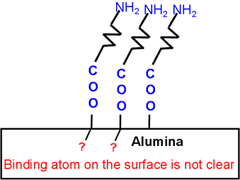
|

Optical fluorescence images of plain (left), and
Aminocaproic acid reacted Alumina surface (right)
treated with Fluorescein Isothiocyanate (FITC).
|
|
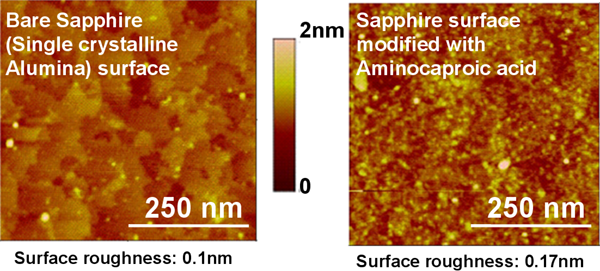
AFM images of plain (left), Aminocaproic acid
reacted Alumina (Sapphire) surface (right) treated
with Fluorescein Isothiocyanate (FITC).
|
|
Application
to Peptide Immobilization and Cell Adhesion
We are carrying out the controlled adsorption
of peptide chains that induce the attachment and
growth of hippocampal neuronal cells such as neurons
and glia on glass and alumina substrate surfaces
subsequently rendering them biocompatible. Non-conducting
substrates such as glass and alumina form the
platforms for most prosthetic implant devices.
Our strategy employs controlled adsorption of
specific neuronal cells through modification of
the surfaces of prosthetic implant electrode arrays
by designed organic, self-assembling, bi-linkers
that at one end bind covalently (and thus strongly,
for mechanical stability) to the prosthesis surface
and at the other end contain specific cell receptor
recognition peptide in a conformation that enables
adsorption of specific neuronal cells through
receptor-ligand recognition and binding. The penta-peptide
IKVAV has been identified as a sequence that is
recognized by the neuron cell surface receptor.
Similarly, KHIFSDDSSE is a peptide sequence that
is recognized by the glial cell, specifically
astrocyte surface receptors. We therefore chose
to modify our surfaces with organic molecules
designed to immobilize each of these peptides
and subsequently expose them to neural cell culture
environments to compare the cell adhesion / repulsion
induced by such peptide modified surfaces.
|
|
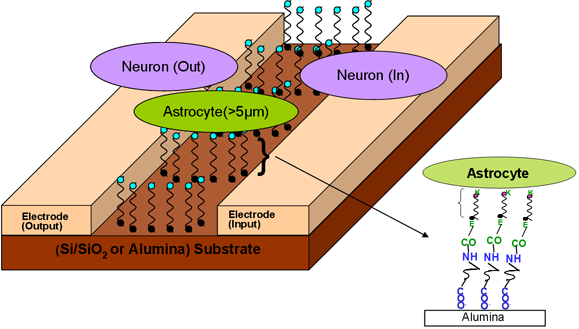
Schematic illustrating selective cell adhesion
onto peptide modified prosthetic surface.
|
|
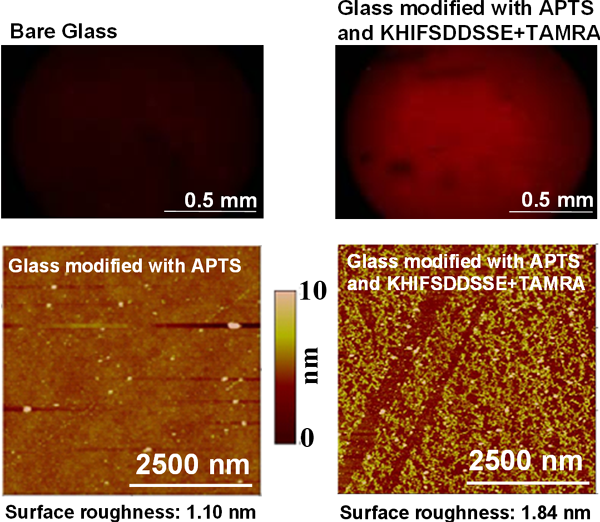
|
|
Optical fluorescence using peptide conjugated
dye, TAMRA (top panel) and AFM (lower panel) images
of glass surface without peptide (left) and surface
reacted with peptide (right).
|
|
DURINT
Project
- Nanocrystal/Eptaxial
2D integration
- Surface
Modification (Chemical & Biochemical)
(Current Page)
- Nanoscale
Simultaneous Morphological & Optical Imaging
Back to top
|
|
|
|
|